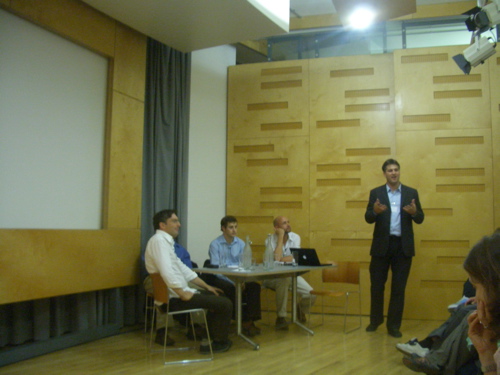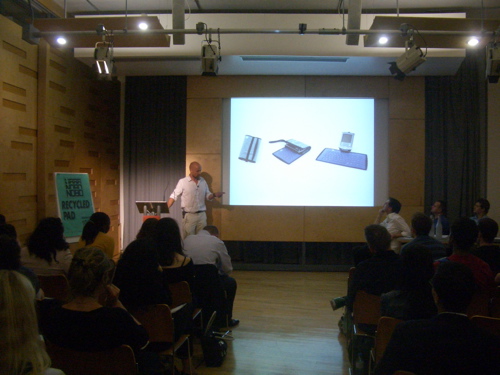Event announcement and speaker biographies
See event information on the Own It site. The event was also listed on the London Design Festival site.


Panelists
Michael Kowalski, Kitsite
Hugh Mason, Pembridge
Partners
Dominic Speller, CPA
Dave Sandbach, IOGI
Chair: Nico Macdonald,
writer and design industry consultant
Follow-up
- Pembridge business benchmarking, Pembridge Vital Statistics, supported by Business Links London
- Contact report template from Dave Sandbach: IOGI_ContactReport.doc [Word, 60 KB]. This shouldn’t be used instead of applying for formal IPR protection where appropriate. It should instead be used to help support the non-formal IP position: by managing communications and forming a record that an idea was disclosed, preferably under agreed conditions of confidentiality – a nondisclosure agreement. To use you will need to customise (logo, layout and font preferences, etc). The notes in each section should ideally be brief, without excessive detail and the actions column is usually just initials and dates – who’s doing what by when. Items covering confidential information should refer to the owner of the information. Usually this can be done without sounding too ‘legal’, for example: ‘DS explained the principles of IOGI’s confidential concept of... and described the following ways that this might apply to... products...’.
Related events
-
20 Sept and 25 Oct 2006: I’ve got an idea – what next? (The British Library)
-
September 21 2006: NMK Nirvana Business Development Programme
-
September 27, 2006: Exploring Innovation Forum (Bloomberg, Finsbury Square) Part of the London Design Festival
-
This year’s D&AD Congress 2006 Week Four featured Training and Advice sessions for graduates on ‘How to start your own business’ and ‘How to make your ideas your own’. Next year’s Congressmay have similar sessions.
Further reading and listening
Innovating the Web Experience series ‘Building Your Own Start-up Technology Company’ Dirk Knemeyer, Digital Web magazine, March 14, 2006. Part 2/Part 3/Part 4. An excellent article series that covers the issues around designing a business following a similar structure to this event. It is oriented to online products, but many points are of general relevance.
Ryan Carson talks about developing a scalable software application/business [streaming MP3], focused on his DropSend application, at the Carson Workshops Summit – The Future of Web Apps in London in 2006. Also oriented to online products, but many points of general relevance. A general theme is controlling expenditure during the startup phase.
Chicago-based 37signals’ book Getting Real on “the smarter, faster, easier way to build a successful web application” based around their move from being a design studio to creating successful Web-based applications such as Basecamp. Again, oriented to online products.
Key themes and points
Michael Kowalski, Kitsite
On partners: we worked well together and could argue.. First client allowed us to live off revenue... Most business is just business... People don’t buy innovation... User experience is a hard sell... Sell yourself: use your network... If your customers are your friends that is a good place to be... Everyone thinks they are an interaction designer... If your ideas are easy for someone else to do then they are probably [not strong enough]... Shipping brings in revenue, and real users for feedback... NDAs: we don’t do them any more
Hugh Mason, Pembridge Partners
Same issues crop up in different companies... Know yourself [what kind of company you are]... [Make sure] the business is separate from the people who run it... “Nothing gives me more pleasure than creating something and walking away from it.”... [Investors are] more interested in geese than golden eggs... Most businesses fail within first two years... investors think in terms of physical assets... [And they] don’t invest in business plans but in teams of people who can solve problems... [Ensure you have the key management positions filled]... Stick to the business plan format... Prove you can deliver beyond spreadsheets... Products don’t ‘sell themselves’... Pitch the firm, not the product... Investors don’t like businesses which need large investment upfront or which have costs scaling with sales.
Dominic Speller, CPA
Make IP research part of your brand... Every company is an Internet company. Domain registration is an effective way of getting brand out early... [If you don’t do your prep properly you risk] wasting revenue and time on creative process and losing possible sales... [Examples of use of Overture tour of word associations and DomainSurfer... [Case study: Olympics/London 2012: inadvertent infringement]... [Case study: Starbucks: explicit infringement]... Resources: UKPTO site, IP Review magazine (free subscription available), IPKat (Weblog with UK and European perspective on copyright, patent and trade mark issues), Managing Intellectual Property magazine, Trademark World magazine and Patent World magazine (from IPWorld Online), Intellectual Asset Management magazine... Keep an eye on IP early on.
Dave Sandbach, IOGI
Don’t shield ideas... Protect stuff that
gives you most advantage... [Protecting IP need not be expensive]...
Much is free in IPR... About tipping the balance in your favour:
make it easier to do business with you than work around you... Take
all ideas, write them down, think of them as manageable... Work under
controlled confidentiality or “just do business”... [Case
study: Eleksen] Idea around softness of human beings and technology...
Thought about what we were selling as a bundle... Did a deal with
a patent agent... “We had an IP strategy right from the beginning”...
Aimed to make real products that were manufacturable in this (currently
small) sector... Business plan around four sectors: toys, PDAs, automotive,
healthcare (latter two would have taken 7 years to build... Easy
to generate excitement when something looks new, but harder to close
deals... The ‘grow-fast’ strategy required serious investment – hence
the VC route.
This route (by definition) means losing a lot of control and should
be
thought about carefully (ie: make sure the strategy behind it is
the right
one) – VC investment required bringing in ‘senior’ management, and
a larger
team: in this case 30 people. The whole thing then gets a momentum
of it’s
own... “you are suddenly responsible for all these
people”... Developed concept products with IDEO to “spell
out the message”. Put them in public domain, which stops anyone
else patenting it... Choose strategic positions to protect... [Case
study: USB Cell] Business designed
as an ideas factory around renewable energy and re-cyclability... They
know their investment/exit strategy... [Conclusion] Backup NDAs with
contact reports. Say who is the owner of idea, the proposal, action
notes, and what is confidential. Send to the company you met to agree
as a statement of the meeting.
Possible issues for discussion
What are creatives least good at? Connections,
finance, selling, branding & markeing
Business viabiity and business plan
Value of (market) research
Process of innovation (and funding R&D)
IP protection
Trademarks, etc.
Structure of company
Vision for company
Hiring and HR
Finances: where do SMEs normally fail? Keep selling! Use of equity
What are the design skills that can be applied? Research, understanding/being
close to customers, communication, lateral thinking, conceptual thinking,
prototyping and testing
Marketing: PR, online
Professionalism, eg: doing the paperwork
New business development: familiarity and trust
Sales and payment
Service and management
Pitfalls
Exit strategy
Presentation from Michael Kowalski
By Michael Kowalski
What we do
History
Things we’ve learned
- Most of your business is just business
- Beware of sleeping partners
- People don’t buy innovation
- User experience can be a hard sell
- Sell yourself
- Use the web as your marketing and sales channel (if you can)
- Just ship!
Things that didn’t matter
- contracts – tend to be post-project
- NDAs
- trade shows
- market research
How to attract an investor
By Hugh Mason, Pembridge Partners
Part 1: Know yourself
- Why are you in business?
- What are you trying to fund?
- What stage has your business reached?
Part 2: Know your investor
- Terminology
- The challenge for Creative Businesses
- Inside the investor’s head
Part 3: No surprises
- Team
- Format of proposal
- Do’s and don’ts
Designing a business – creating IP
By Dominic Speller, CPA
Top Tips to get a protected brandDevelop your brand
- Trademarks – Physical
- Domain and Internet presences – Digital
IP research
Be creative, but realisticDigital
- The Internet is more important than you think
- Domain research tips
Trademarks
Trademarks can be an expensive business- Case study: Starbucks
- Case study: Olympics
- Trademark research tips
IP resources
IP resources to stay on top of the industryDesigning early stage businesses around smarter use of IP
By Dave Sandbach, IOGI
IP misconceptions
These don’t really apply to early stage companies:- Fortress mentality
- Only the most clever, complex ideas should be protected
- High cost
Instead:
- IP is for doing deals – open up...
- Tipping the balance – easier to do business with than to work around
- Spend can be low at first – beef up later
What to protect
- Only a subset of IP is suitable for formal protection as IPR.
- Choose based on value to the business
- A lot can be done with the non-formal IP
Case study: Electrotextiles
- IP strategy coordinated with business strategy from the beginning
- Product concepts in key markets
- Brainstorm before meetings – document ideas – share with customers. Only one or two product concepts protected formally
- Investment and product development story
- Products and story, including Logitech keyboard
- Lessons
Case study: Moixa Energy
Advice
- Document ideas! Start to manage ideas by documenting and dating them
- Use NDAs where possible, and file (early stage) IPR applications
- Thus can be open and sharing

